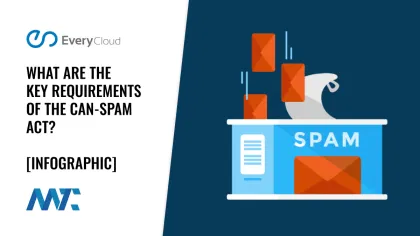
United States regulations covering commercial email messages were regulated in 2003 under the Federal Trade Commission’s CAN-SPAM Act (CAN-SPAM). While it’s been over a decade… I still open my inbox daily to an unsolicited email that has both false information and no method to opt out. I’m not sure how effective the regulations have been, even with the threat of up to a $16,000 fine per violation.
Interestingly, CAN-SPAM doesn’t require email permission, as other countries’ commercial messaging laws have been established. What it does require is that the recipient has the right to have you stop emailing them. This is known as an opt-out method, typically provided through an unsubscribe link in the email’s footer.
This beginner’s guide to the CAN-SPAM Act infographic below will provide you with key information you need to know to ensure you abide by the law.
Key Requirements of the CAN-SPAM Act:
Ensuring you comply with CAN-SPAM laws is the first step to getting your emails through email filtering and into your subscribers’ inboxes.
- Ensure accurate header information: Your messages must have correct From, To, Reply-To, and routing details, accurately identifying the sender.
- Avoid deceptive subject lines: The subject line should represent the message’s content truthfully.
- Clearly label messages as advertisements: You must unmistakably disclose that your communication is an ad.
- Provide your location: Include a valid physical postal address, which could be a street address, a registered post office box, or a mailbox from a commercial mail-receiving agency.
- Offer clear opt-out instructions: Explain how recipients can easily opt out of future emails. Ensure that the instructions are clear, readable, and accessible.
- Process opt-out requests promptly: Implement an opt-out mechanism that works for at least 30 days after sending the message. Honor opt-out requests within ten business days. No fees or excessive information should be required to opt-out.
- Safeguard opt-out requests: Make sure spam filters don’t block opt-out requests and refrain from selling or transferring email addresses after opt-out, except to assist with CAN-SPAM compliance.
- Maintain oversight of third-party actions: Responsibility for compliance cannot be contracted away, even when outsourcing email marketing. The promoted company and the sender might be held accountable for legal compliance.
Compliance with CAN-SPAM doesn’t mean your email is going to make it to the inbox, though! You may still be blacklisted and blocked or sent directly to the junk folder depending on your deliverability, reputation, and inbox placement.